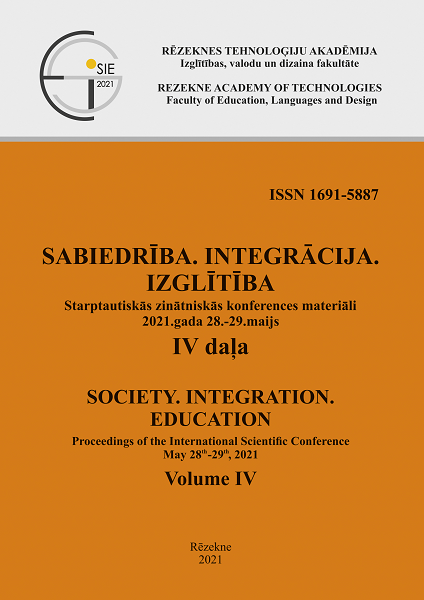DISCOURSES ON THE CONCEPT OF THE MONUMENT “UNITED FOR LATVIA” IN LATGALIAN PRESS (THE 1920S AND 1930S)
DOI:
https://doi.org/10.17770/sie2021vol4.6192Keywords:
discourses, Latgale, Latgalian press, monument “United for Latvia”, RezekneAbstract
The monument “United for Latvia”, unveiled in the centre of Rezekne in 1939, is dedicated to the participants of the Latvian War of Independence (1918–1920. ), who took part in the liberation of Latgale from the Bolsheviks. In a broader sense, it symbolizes the whole Latgale, the liberation of the people from foreign powers, as well as the unity of Latgale with the rest of Latvia. Nowadays, the monument is a signature of Latgale, its image is widely used in booklets, souvenirs, on the covers of books and brochures, in advertisements, etc. Despite the significance and popularity of the monument, its history has been little studied. Before the monument was erected, there was a series of discourses on its concept in Latgalian press. The aim of the article is to identify in the course of the exploration of Latgalian press publications the direction of the public opinion in the 1920s and 1930s on the discourses of what should be the ideological and visual appearance of the monument of the liberation of Latgale and its unification with the rest of Latvia. The study is based on the historical approach to discourse and qualitative, comparative analysis of information. The study examines two topics of discourse: the choice of the monument site and the type of the monument; the ideological and visual solution of the monument.
References
Barrachina, G., S. (2020). The fragmented history of public monuments: the identification process and its meaning today. Arte y políticas de identidad, 23, 182–198. DOI: https://doi.org/10.6018/reapi.461221
Borbals, A. (1933). Kaidam jobyut Latgolas breiveibas pīminekļam, Latgolas Vōrds, Nr. 15-16.
Borbals, A. (1934). Par Latgolas breiveibas pīminekli. Latgolas Vōrds, Nr. 15.
Brolišs, J. (2000). Nacionālie procesi (būtība, tipi, veidi, pretrunas, izpausmes). Rēzekne: Rēzeknes Augstskola.
Delanty, G., Wodak, R., & Jones, P. (2008). Identity, Belonging and Migration. Liverpool: Liverpool University Press.
Erss, Ā. (1932). Latgalē. Pēdējā Brīdī, Nr. 81.
Jēkabsons, Ē. & Ščerbinskis, V. (2006). Latgaliešu politiķi un politiskās partijas neatkarīgajā Latvijā. Rīga: Jumava.
Kemps, F. (1934). Kas byus ar myusu pīminekli? Latgolas Vōrds, Nr. 16.
Kozlovskis, E. (1934). Latgolas atbreivōšonas pīmineklis. Latgolas Vōrds, Nr. 13–14.
LRSSS. (n.d.). Latvijas Republikas Satversmes sapulces stenogrammas. 4. ses., 1525. sl.
Lukaševičs, V. (2012). Latgolas Muora. No I. Šuplinska (galv. red.), Latgales lingvoteritoriālā vārdnīca I (389–391). Rēzekne: Rēzeknes Augstskola.
Počs, K. (1997). 1917. gada Rēzeknes apvienošanās kongress un tā nozīme Latgales vēsturē. No: Unda, V. (red.). Rēzeknes kongress (1917–1997). Zinātniskās konferences materiāli. Rēzekne: Latgales Kultūras centra izdevniecība.
Red. (1934a). Latgolas atbreivošonas pīminekļa ceļšonas konkursa nūteikumi. Latgolas Vōrds, Nr. 26.
Red. (1934b). Latgales atbrīvošanas pieminekļa projekti. Atpūta, Nr. 522.
Red. (1934c). Rēzeknē cels pieminekli Latgales atbrīvošanai. Jaunākās Ziņas, Nr. 56.
Skujenieks, M. (1931). In M. Skrujnieks (Eds.), Trešā tautas skaitīšana Latvijā 1930. gadā. Rīga: Valsts Statistiskā pārvalde.
Strods, P. (1924a). Latgolas atbreivošonas pīminekļa lītā. Latgolas Vōrds, Nr. 4.
Strods, P. (1924b). Latgolas atbreivošonas pīminekļa lītā. Latgolas Vōrds, Nr. 7.
Strods, P. (1925). Latgolas atbreivošonas pīminekļa lītā. Latgolas Vōrds, Nr. 5.
Tetters, A. (1924). Kaids vords Latgolas atbreivošonas piminekļa lītā. Latgolas Vōrds, Nr. 6.
Vārōtōjs (1934). Atbreivōšonas pīmineklī – progresivu ideju! Jaunō Straume, Nr. 9.
Zeile, P. (2006). Latgales kultūras vēsture. Rēzekne: Latgales Kultūras centra izdevniecība.






